

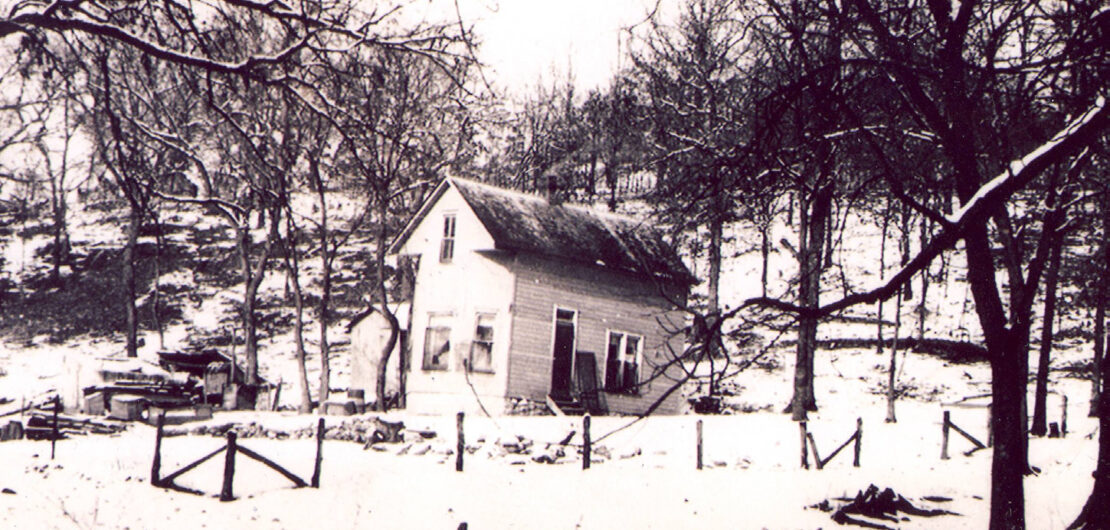
It sat not far from the banks of lost Creek. Lora Greenfield Smith remembers it as “the Pink House.” Dee Nelson Griffith remembers it as the house where she grew up and her youngest brother Butch was born. Butch Nelson remembers it as the house that had a cave near it where he frequently played. Some remember it as the “Shawnee House” because Shawnee Indians usually lived there. I remember it as the Dushane House, not Chief Dave and Allie’s home place, but the Dushane House because so many Dushanes lived there throughout the years.
Not far from the banks of Lost Creek, Lora Greenfield Smith remembers it as “the Pink house.”
The house was there when Nina Dushane Greenfield sold the 58.19 acres located in the Shawnee Reserve back in 1937. Nina, her husband and their children had previously moved to the area of Colony, Oklahoma, located in the Kiowas Agency. In a recent letter dated May 2009, Nina’s daughter Lora recalls visiting the house and Lost Creek. “When I was a little girl, my mother Nina (Dushane) Greenfield and my sister Norma (Greenfield) and I went to Seneca to the ‘pink house’ in the early 1930’s to see Uncle Jim Chandler and Aunt Lena (‘Shorty’-a nickname).
“It was a joy to go to Lost Creek to play in the creek. We would take a tobacco tin container, hold it near a crawdad and back it into the can.
“We were also scared of leeches, and someone always in fun would say-‘you have a leech on your back.’ That would end the fun for Norma and me.”
Dee Nelson Griffith remembers the house as it stood in the 40’s. She never knew it was referred to as the pink house because she said it certainly was not pink when she lived there. The two-story house sat up on a knoll. When the creek flooded, which Lost Creek frequently did back then, they were stranded because even though the house never flooded, the road to it did. Dee stated that her mother and father, Vance Dushane and Forrest Nelson, lived in the house from about 1940 to 1950’s with their five children-Marcella Dee, Buddy Charles, Josephine, Carmalita, and Butch. It was Butch who was born there. Dee described the house as salt box styled and certainly not spacious. It was a two storied structure, having 2 bedrooms upstairs, 2 rooms downstairs. About five feet behind the house was a retaining wall made of field stones. Butch recalls being outside more than he remembers being inside, saying he went up and down the creek and all over those hills. His favorite haunts were the cellar and the cave.
“Pink house” on the banks of Lost Creek.
When Vance Dushane and her family moved out, another Dushane family moved in. First it was Nina Dushane’s land, then Dave Dushane was elected Chief, then Vance Dushane lived there and this time it was Madelyn Dushane, sister to Vance and daughter to Chief Dave and Allie. No wonder many remember it as the Dushane House. Madelyn Dushane Rosenow, her husband Art and their children lived in the house until it burned.
My memories from the late forties, early fifties are more of the road and the buildings leading to the house than the house itself. It stood in Oklahoma on the north bank of Lost Creek but access to the property was from Main Street, Seneca, Missouri. Main Street of Seneca runs north and south with Mill Street running east and west. The house was the final stop via Mill Street, located less than one mile west of the present stop light (the only one) on Main Street in Seneca. It may have been less than one mile but to a little girl, it seemed like it was “out in the boonies” as we used to say.
Seneca, Missouri around 1930’s.
That might be because the Pink house or the Dushane house was down Mill Street where the remains of an old distillery stood. Years earlier, a gentleman named Mr. Schreiner, some sources list Shriver, bought “a patch of ground outside the platted portion” of Seneca where in 1889 he built a distillery near Lost Creek and over portions of a spring. Just west of the distillery he added a large hay barn and some cattle sheds he filled with hay. According to an article in the November 25, 1898 Seneca News Dispatch, he then bought corn for his cattle, extracting the “spirtus frumenti” from it before feeding his heard. That distillery had the capacity of 30 gallons per day. Getting to the “house” meant passing several businesses, the old distillery, the aged barn, the sheds and who knows what else. Finally the business road then turned into a narrow, winding lane hugging Lost Creek on the south with bluffs jutting ominously on the north, ultimately opening up to a field with an isolated house standing in the middle of nowhere.
Today Mill Street in Missouri ends before reaching Eastern Shawnee land in Oklahoma. Today no remains of a distillery, a barn, or cattle sheds stand. Today pow wow grounds accessed from the Oklahoma side spread across lands formerly covered with wheat or soybeans. Today a bridge spans the stream, making the North side accessible from the Oklahoma side. Today a small age worn building that formerly housed our first nutrition program hugs earthen banks now known as Tecumseh Park. Yesterday, in fact many yesterdays ago, a two storied house with a retaining wall five feet behind it stood isolated on the banks of Lost Creek.
(Information came from personal interviews, letter written by Lora Smith, November 25, 1898 issue of Seneca News Dispatch and Seneca, Missouri The Little Town on the Border Volume 1 1981.)

With only one week remaining before January 1, 2020, a critical date for all Oklahoma Tribes and for Oklahoma Governor Kevin Stitt, the battle between the tribes and the Governor heated up even more when Lisa Billy, Secretary of Native American Affairs, abruptly resigned. Stitt and the tribes have locked horns over that January 1, 2020 date with tribes adamantly insisting that exclusive gaming compacts automatically renew that date while Stitt argues they do not and must be renegotiated. Stitt wants to increase the percentage tribes pay for exclusivity fees, meaning that only Native American Tribes can operate casinos in Oklahoma. Small tribes argue that overall the state is receiving more money each year but most small tribes because of increased competition maintain they are making less and cannot afford to have fees increased. It is generally agreed that four or five large tribes in Oklahoma account for 75 percent or more of the total gaming revenue. Stitt indicates that if the exclusivity fees are not increased, commercial gaming could be allowed in the state. As a small tribe, we are definitely impacted by the outcome of this stalemate as it is one of the most critical issues that will face this tribe in the coming years. For that reason, I include the following article recently written by Janelle Stecklein.
“Oklahoma’s first secretary of Native American Affairs abruptly resigned Monday, December 23, saying she can no longer serve a governor who is ‘committed to an unnecessary conflict that poses a real risk of lasting damage.’
In her resignation letter, Lisa J. Billy said she had hoped serving in Republican Gov. Kevin Stitt’s Cabinet would allow her to be part of an effort to deepen and strengthen Oklahoma’s relationships with sovereign tribal nations.
But she said it’s become increasingly clear that Stitt is committed to “an unnecessary conflict” that poses the possibility of long-term damage to the state-tribal relationship and the economy.
‘You have dismissed advice and facts that show the peril of your chosen approach and have remained intent on breaking faith with the tribes, both by refusing to engage with the compact’s language and, more recently, by suggesting you would displace our tribal partners with private, out-of-state commercial gaming operators,’ she said.
‘Your actions have shown that my continuing in service on your Cabinet is unnecessary to you and impossible for me,’ said Billy, who also serves as a Chickasaw Nation lawmaker. Stitt remains at an impasse with 35 of the state’s tribes over whether the compacts automatically renew Jan. 1. The Republican governor contends they expire.
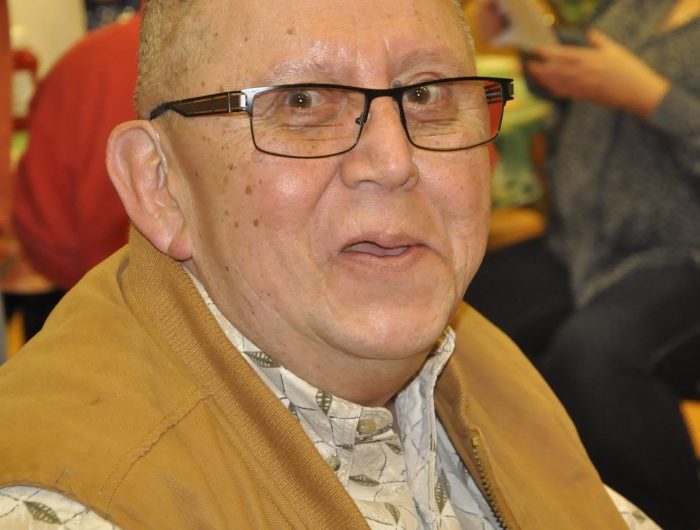

He’s never been alone. He has always had someone in his life, most of the time quite close in his life. It started with his sister Sherry, his woomie. No, that’ not a typo. Steven no middle name Daughtery shared his mother’s womb with his twin sister Sherry. He was alone for thirty whole minutes as Sherry was born first. Even then he was really not alone as he was connected with his mother, but thirty minutes later Steven joined his older sister, a fact he likes to point out, rather loving that word “older”. The woomies made their identities known to their parents John Daugherty Sr. and Victoria Naomi Secondine Daugherty at Claremore Indian Hospital in Claremore, Oklahoma on May 8, 1954. Later they joined their siblings Pat, John Jr, and Rusty at the family home in White Oak, just outside Vinita, OK.
White Oak was and continues to be a major role in Steve’s life. His father was Eastern Shawnee while his mother and grandmother were Loyal Shawnee with his grandfather Anderson Secondine being full blood Delaware. Eastern Shawnee, Loyal Shawnee and Delaware—that’s Steve’s bloodlines. His father wanted his children to be enrolled with his tribe, the Eastern Shawnee and so they were and are. Steve and his siblings grew up in the White Oak community, just up the hill from the Loyal Shawnee Ceremonial Grounds, the place of their worship for their entire lives as their mother was eventually the head lady. As a child Steve heard the Shawnee language spoken in the home as both his mother and grandmother spoke Shawnee. He and his siblings loved the spring, summer and fall months as they could basically live outdoors, much of that time in the creek at the foot of the hill. That creek in the old days was the site where the skinning of the corn occurred in preparation for the Bread dances.
Steven and his siblings went to school at White Oak, beginning in the first grade and graduating from high school there. At that time White Oak had all 12 grades. The elementary school remains today but high school students go to Vinita. Steve does recall that he had a rebellious streak and began to skip school, misbehaved, in general became a problem student and thought he wanted to quit school. That resulted in his spending his 9th grade at Sequoyah Indian School where he had to live there as well. For the first time, he felt alone. They had strict rules at Sequoyah, only a couple of students spoke the Shawnee language, and surprisingly enough, he missed his family and family rules. He found he didn’t like being alone. His attitude changed, he returned home a year later, gladly attended high school at White Oak and graduated from there.
After high school Steve went to work at J.C. Penney’s in Vinita starting as a stockman then working in the catalogue department, ultimately ending up in the shoe department. Living at the Sequoyah Indian School taught Steve that he didn’t like being alone, that he had no desire to leave home immediately after high school graduation. He remained at Penneys for eight years. During this time Steve’s father walked on at the age of 47 where he died at a TB sanatorium. Other life changes occurred, including other jobs, marriage at the age of 27 then the birth of Steve’s two sons, Steven Leon and Michael Wayne.
From the experience gained at Penneys, Steve moved on to Walmart, beginning at Vinita then Miami and ultimately Baxter Springs where Steve was Support Manager. While he was working at Walmart, Paul Thomas of Paul Thomas Funeral Home met Steve, liked him and was impressed with his demeanor and work ethic. Paul Thomas asked if Steve would like to work at a funeral home, that he thought it would be a good fit for Steve’s personality. That led to Steve being employed there making funeral arrangements, assisting at funerals, etc., a job that lasted 12 years. However, the hours weren’t the best, Steve was now divorced, and in 1999 he took a job as a security guard at the Seneca Cayuga Tobacco Plant. At that time, the wages were excellent and the hours much better than those associated with the funeral business. After the Seneca’s built a huge tobacco warehouse, Steve became the warehouse manager.
It was there that Steve meet Sharon Thomas and his wife since 2001. Sharon had been a purchasing agent at FAG in Joplin then became purchasing agent for Seneca Tobacco, owned by the Seneca Cayuga Tribe. The tobacco plant was the first job Steve had with an Indian Tribe but others followed. He was AOA Director for the Quapaw Tribe for five years. Once again Steve’s work ethic and his demeanor positively influenced another person—Barbara Kaiser, long time Gaming Commissioner for the Quapaw Tribe. Barbara noticed how well Steve worked with the seniors and asked him if he would be interested in calling Bingo. He started as a part time caller, took training at Sandia Reservation, then became head caller for the Quapaws. He recalls that everything was different in 2005. Players were quite serious with many of them traveling on buses from St. Louis and the minute they got off the bus, they were ready to play. He made many friends while being a Bingo caller and recalls Bingo being a large part of his life for several years. Laughingly he states he never goes to a Bingo Hall now, never plays Bingo anymore. Immediately he backed up, retracted his statement adding that he and wife Sharon played Bingo on the recent AOA bus trip to Branson but all his years working in Bingo didn’t help him one bit as he didn’t win a single time. After Quapaw, Steve was employed at several other gaming establishments, including the Eastern Shawnee Outpost where he permanently retired from in 2016.
Fast forward to now, 2019 and you’ll find Steve and Sharon living at the Woodlands in one of the duplexes just built. He explains that they wanted to live in the Woodlands for several reasons. First, both he and Sharon have health issues with one of them having had a triple by-pass surgery and the other a quadruple by-pass. No longer able to climb the stairs in their home and no longer able to do maintenance required, they knew they had to make changes in their lifestyle, had to downsize. During this time they had been coming to the Wellness Center three times a week for a couple of years, particularly since the Aquatic Center had been built because of Sharon’s need to exercise in a therapy pool. When they learned that additional duplexes were going to be built at the Woodlands, they immediately filed an application.
Now, two years later, Steve and Sharon say living at the Woodlands is all they hoped it would be and more. The AOA is near where they can eat and socialize every day, exercising at the Wellness Center is so convenient, they love their neighbors, they are now able to participate in tribal events such as the recent trip to Branson, they can now volunteer to help with events which they both did for Trunk or Treat and they look forward to even more volunteer opportunities. Next on their list is to find a church closer to their new home now. The fact that Steve’s son is pastor at a church just a few miles away just might make that decision an easy one, don’t you think? As they said, the Woodland is all they hoped it would be and more.
Throughout this interview, Steve consistently made references to White Oak, the ceremonial grounds there, activities there, friends there. We’ll continue that discussion next month.
Pocilikwe for woman.
Pocili for men.
The helpers down at White Oak Grounds.
You were asking about Missy’s position down there!
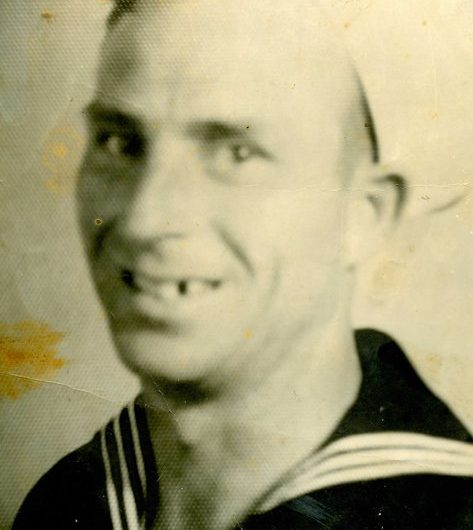
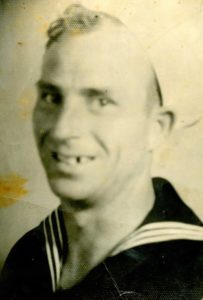
Recently my younger brother Bud shared Aunt Opal’s Bible with me. Aunt Opal was my dad’s closest sister and has been deceased for several years. Aunt Opal Cousatte, married to Buster Cousatte, was a woman filled with spirit—spirit of laughter, spirit of love, spirit of God. She and Uncle Buster never had any children and since my father, Champ Enyart, was the youngest in a large family and only six months old when his father died, Aunt Opal and Uncle Buster had special feelings for Dad.
Aunt Opal was a saver. She came by it naturally. When Grandpa Enyart died, Grandma Enyart was the only means of support for all those children. It was before the time of social security, before the time of widow’s benefits, before the time of welfare checks. She cleaned houses, worked in cafes, took in washings, ironed clothes, mended clothes, raised chickens, cooked chickens, rabbits, squirrels, possums and raised gigantic gardens. Aunt Opal learned from a master saver.
And so it was with Aunt Opal’s Bible. There were almost as many pages of clippings, poems, obituaries, pictures, announcements, and letters tucked inside her Bible as there were original pages of scripture. Included in those letters were letters I had never read, letters written from my father to his sister, my Aunt Opal, and to his mother, my grandmother Anna Enyart, written while he was serving his country in World War II when he was drafted seventy-five years ago, even though he was married and the father of five children. The letters spoke of his love for his family, his loneliness from missing them, how he spent his time and his wishes for his loved ones.
I was deeply touched by those letters. I thought of the many others who have served our country, who have been separated from their families, who had to have experienced and written about many of the same topics, same feelings my father discussed. These letters of long ago that I was reading for the first time made me more acutely aware of the sacrifices our veterans have made, how very much we owe them. It is only appropriate to share these letters with you in the month of November, the month we honor our service men and women, an honor they so richly deserve.
Veterans, I salute you.
San Diego, California
April 14, 1944
Dear Mom & Sis,
Received your letter today, sure was glad to hear from you all. Glad you are well and feel fine, but you don’t worry about me getting fat through boot training. They run it off faster than anybody can put it on, but it is not tough now after getting my wind back and soreness worked out. We run the obstacle course one time daily, that is going up rope ladders and over the other side, then run one mile jumping hurdles shoulder high, jumping ditches, going across a two by four hand over hand, about 50 feet jumping logs, and about everything you can think of. Then, in the evening just before supper we run one mile in a circle. But it is easy to do now, was pretty tough at first. About California, it is not what you would expect. You think it is hilly at home but that is all there is here, mountain after mountain, with irrigated valleys between but the valleys are sure pretty. The orange trees are not very tall, about 20 feet but they are branchy so about as big around as tall. The timber is all scrubby around here and it is always cloudy in the morning, but the sun shines every evening. The sun comes up in every direction to me.
Say, I run across Stivers the other evening we talked a long time, then two days later after supper he came over to my barracks for about two hours. He is about one and a half weeks ahead of my company in boot, he went over to the next section of camp yesterday, but we will go over in about one week. There are three sections of boot training. One is three weeks where I am now, then two in the next one, then we go to the last one- that is only the shipping out point. There is lots of fellows here that I know, have worked with about 30 of them. Yes Skye is here but has been in sick bay most of the time, the shots and training was too much for him, but they fall out all along the line. I look for Skye to get a discharge before long.
About me taking up gunner, that is what I really wanted. I will be on the top deck all time where I can see what is going on and can get a crack at the enemy. I could of taken sub, cooking, or went to school but I didn’t want under the water and I sure didn’t want around no damn stove and am too old to go to school so I took just want I wanted. Virgie ought to make it fine, for she ought to have got two checks by now, for they pay back one month before inducted and one in advance.
Tell Buster I said hello and would like to go hunting with him. Tell him I said he had better go on to harvest and get out of them damn mines. I never expect to work in them again. We got in five weeks what it took in eight months in peacetime to train, but I get a kick out of it now. I don’t expect I will come home before I go to sea cause I can’t possibly save enough by boot ending time. My insurance cost me $7.40 a month and I think they hold out for three months at a time so will draw about a five spot. That will be plenty to get me by on. They damn near cut all of my hair off. You talk about fast barbers! They got them here the first day in camp. Six barbers in one and a half hours cut 720 sailor’s hair and I was one of them. One barber cut’s two head of hair in one minute, that is the truth! It takes you longer to get in and out of the chair than to get it cut. We all look like convicts now.
Say, some homemade candy would go good all right, but we can get stationary here at the canteen. I had to work yesterday helping clean up the canteen so you can guess about how much ice cream I ate. We have from 5:30 until 9 off but we have got to do our personal work then such as washing every day, shaving, taking a bath, cleaning up our barracks, then we set around dueling one another. But when one gets acquainted with the routine it is not bat at all. Some don’t like it, but they mostly are guys that are a sissy or some tender foot that never did do any thing and couldn’t make it anywhere. They say it gets better as one advances. This camp here is the worst one of all, but it is not bad to me now, it is just to get one in physical conditions to go on to duty. Some of these guys get around like grand pappy’s, can’t take the exercise they give them. Ought to hear our leader talk to them! I have got along good in everything so far and it is getting easier all the time. Well I have got to help clean up so will close with love your son and brother. CC [Champ Clark Enyart]
Ans Soon
By
San Diego, California
April 23, 1944
Dear Sis & Mom,
I read your letter, sure glad to hear from you. Glad everybody is well back there. I am feeling fine. We have completed all of the tough training, I stood it okay. It wasn’t bad to take after I got adjusted to it.
We are in another part of camp now. We have got one week of work ahead of us, stenciling new company sleeping material, then we go to another part of camp to be shipped out. Some will get leaves, some to sea, one never knows until he gets there. Our training is completed here now, except marching to and from church and taking exercise. We took the No. 2 swimming test yesterday. It was tough to make, only ten out of 175 made it. I was one of them, but I was all in at the finish so was the other guys. We got all the swimming we wanted for a while. Got another damn haircut yesterday. They sure believe in hair cutting here, one every week. We sure have been lucky, got the best company commander here, he is just a regular fellow. He will be with us until we scatter. That won’t be but two weeks at most. We are eligible for call now but he said he believed it would be a couple of weeks yet.
Virgie wanted me to come home on leave. I would like to, but it cost a hell of a lot for just five days at home. About $40.00 for a round trip ticket. It probably would do the kids more good to buy them something that they need. We got liberty Monday. I got beat out of the ball game today, got to stand guard from 12 until 4. We get to sleep until 6 o’clock now since we have moved.
I don’t believe I will get to see Stivers anymore. He probably is on leave or gone to sea or getting ready for one or the other. Skye is still with us. I don’t know why, for he has been in the hospital half of the time, hasn’t taken hardly any training. About ten was put back in new company because they couldn’t make it. About five was given releases. About clothes, I got more damn clothes than I want. We have what they call a sea bag to keep our gear in. Sure a hell of a job if one wants something out of it. Sure will be in the bottom then everything to replace is under then to retie on our bunks. We stand inspection every day. So far we have passed it in pretty good order. About the new guys that will come in now, it will only be a miracle if I meet any of them, for I am in a different part of camp than the new ones come to. Say they sure are coming and going. In three weeks, there has been 52 company come in, around 180 men to the company. We completed our parading yesterday, sure glad of it. Tell Buster I said hello. Say they sure put us through the mill the last two days. Everywhere we went from one drill to the next was double time. Wanted to see if we could take it, I guess. Mom don’t worry about me for I am having a good time here. We will get to go to a show about three times a week, baseball, swimming, basketball. Well there is any kind of sport games here any one wants to see. I can’t think of anything to say so will close this time, may see you soon as ever. Son & Bro- CC
Ans Soon
San Pedro, California
June 22, 1944
Dear Mother & Sis
Just a few lines to let you know I am ok. Just got this old mug of mine on paper so thought I would send you one you can see what a sailor looks like. While I was at town, I also had my dress jumper cut down. It takes me and my buddy both to get it on and off. I have reached the end on gaining weight and glad of it for I was afraid I would have to get a full new outfit of clothes. Well there is no change as yet in our schedule. We leave here the first of July for Seattle to pick up my ship.
Lester Skye is still here in camp but is not doing any better. He told me this morning the doctors said there was no cure for him so he will never go to sea. He is putting in for a discharge and more than likely, will be back there in about two or three weeks. I sure feel sorry for him and would like to see him get out for he is not a bad guy. I look for the war to be over in about a year, but I don’t expect to get out for about three years, for on the ship I am assigned we will have plenty of water to clear of mines after this is over. Boy, I am still on the ball here. That buddy of mine says he never has to look out for officers or dodge work parties, all he does is follow me around. He said if he could keep up, he knew he would get out of all the work. They say a fellow that can get by easy is a good sailor so I must be one of the best.
Well there isn’t no news here so I will close and drop Eunice a line or two. Haven’t wrote her for more than a week.
I am hoping to hear from you all before I pull out so will close with Love to all. CC
Ans Soon
October 9, 1944
Dear Mom & Sis,
Just a few lines to let you know I am ok and I transferred back to the base here. The ship I was on is ready to leave for the Islands and they say I will get a discharge, so I was sent here to wait for it from Washington. This is not like it was the other time I was here. It is worse than boats, but a fellow can take anything for a while. I don’t know for sure that I get out, but it looks pretty good now. I think I will stop off in Arizona on my way back and look around. If I find a job that satisfies me, I may send for the squaw and kids. Well there is no news and I have a big wash ahead of me. Hoping this catches you all well. Will close hoping to hear from you all soon. Love CC
Ans Soon

The June issue of the Shooting Star included an article about Chief Thomas Stand, an Eastern Shawnee Chief from approximately 1881-1883. Little was known about Chief Stand until a group of students from Miami University in Oxford, Ohio under the tutelage of their professor, Dr. Sandra Garner, researched Stand as a class project. Much of the research involved tracing the lineage of Stand and identifying his Eastern Shawnee descendants.
Researching genealogy, tracking descendants is important to us here at the tribal complex. Because many of our tribal citizens left the Oklahoma region years and years ago, and because we live in such a mobile society today where we have tribal citizens living in every one of the 50 states plus some foreign countries, we have come to realize that often times there are many family members who don’t know some, perhaps many of their own kin or anything about them.
Such is the case with Mark Bolte of Grove, Oklahoma. Immediately upon reading the article about Chief Thomas Stand, Mark called tribal headquarters at the Bluejacket Complex stating that two generations of Stands had been omitted from the article—him and his two daughters, Abby and Sheila. Mark was referencing the paragraph just before the paragraph titled Conclusion. Part of that paragraph reads:
“William P. Stand Jr. was the brother of Olive Mary Stand Higbee, as well as the son of William P. Stand and Olive Gill, and the great grandson of Thomas Stand. William P. Stand Jr. was drafted into World War II and registered with the United States military for his service in October of 1940, at 30 years of age. Stand had a relationship with Vivian C. Williams leading to the birth of William E. Stand, who married Carol Jean Harmon; however, record of their lineage discontinues.”
Mark explained that William Eugene Stand was his father and Ellen Loretta Pike was his mother, not Carol Jean Harmon. Mark’s mother later married Mark’s stepfather and Mark assumed his last name of Bolte. It was later that William Eugene Stand married Carol Jean Harmon and they had no children.
Walking into the office with a big grin and so proud that an article had been written about his family, Mark introduced himself then began to refer to a complete collection of family records that he had accumulated throughout the years and brought with him. Birth records, death records, marriage licenses, newspaper clippings—he had it all. He agreed with everything written in the article, clarifying that a grandmother was referenced some places as Vivian and other places as Clydene. He stated both were correct as her name was Vivian Clydene. The only part he disagreed with was the statement that William E. Stand Jr’s lineage discontinues.
Understanding how information was not readily available about him because of his being adopted and his last name becoming Bolte, Mark indicated he has two daughters, Abby born in 1966 and Sheila born in 1967. Neither daughter has married and neither daughter has children, so to his chagrin, Mark acknowledged that his lineage might discontinue.
Genuinely pleased to read about his relatives, Mark asked if I knew any of them. I told him about Alistair Bane who is an accomplished artist and who frequently comes to the tribe and that just a year or two ago I was able to introduce Alistair to members of the Nichols family, Michael and Diana Nichols whom I had met in Portland, Oregon and who are also descendants of Thomas Stand. I went on to say that Michael and Diana now regularly return for the September powwow with other members of their family. At this point Mark really became excited, saying that he wanted to meet as many of these relatives as possible, that he was going to be at the powwow come this September.
So, Banes, Higbees, Stands, Nichols and all those other descendants of Thomas Stand, the welcome mat is out. Plan on attending the powwow in September, meet Mark Bolte and his daughters Abby and Sheila. It’s time for a family reunion. And relatives, if you want contact information for Mark, just call. He gave permission to share, just not on a national basis.
Thanks again to the students who made this additional connection possible.


“The heart of the matter.” It’s a common phrase, one often heard. “The Heart of the Matter” was the title of a novel by English author Graham Greene in 1948. It is also the title of a song recorded by Don Henley, American rock singer, recorded in 1989. “You’re all heart” is another familiar phrase where the heart is regarded as the center of emotion, sentiment, temperament, kindness, gusto. “Let’s get to the heart of the matter” is still yet another common saying, one often heard, meaning the focal, central, or most important element of a problem, issue, or topic. The topic in this case is Debbie Millhollin Scribner, Eastern Shawnee tribal citizen and the emotion is kindness. She is all heart. When asked if she could have one wish for herself, what that would be, she responded with no hesitation whatsoever, “I want to be a good example. I am a teacher of young children, so I am in a position where I am an example; I want to be a positive example for my students, for their parents and for those around me. I want to be known as having a kind heart.”
The daughter of Maudie Elizabeth Turner and Jasper Charles Millhollin, Debbie was born in Loveland, Colorado in 1956 where she, her four siblings and her parents lived until 1977. Three of the children graduated from high school there in Loveland and the younger two graduated from Wyandotte High School after all five returned to Oklahoma with their parents in 1977. Debbie has four brothers: Billie, Calvin, James and Mark. Living in Colorado came about accidentally. The family was headed to work in the fields in Oregon when their car broke down in Loveland. They had to stay long enough to have the car repaired, found out they liked the area and specifically the town, so they found work and just stayed. Debbie was 21 when she returned to Oklahoma.
Debbie’s first years in Oklahoma were not her happiest years. Married, she became pregnant, the child unfortunately suffered from extreme asthma and passed away at the age of seventeen months. Her streak of bad luck continued as her husband left a week later. Then she was laid off from her job in Neosho, MO where she worked at a chicken plant. That’s when the size of her heart truly began to display its temperament and gusto. She was not a defeatist, never had been and wasn’t going to be one now.
It was now 1980, Buck Captain was Chief of the Tribe and the Tribe was in need of a receptionist. Buck and Debbie talked and at the end of the day she had a new job, a new title. She was now the Eastern Shawnee Tribal Receptionist and Tribal Roll clerk. At that time, there was no 10C. The Eastern Shawnee Tribe was located on 58.19 acres on Oneida Street, West Seneca. On those 58.19 acres were two buildings, one being the original administration building, now named the Chief James Greenfeather Building and the other an incomplete industrial building which ultimately became a Bingo Hall and is now the Annex Building where our Cultural Preservation Department is along with a portion of the Gaming Commission. Then, there was no Bluejacket Building, no Bluejacket Complex.
Debbie fondly remembers those early years. Employees she mentioned included Chief Captain, Robert Alexander, Steve Abernathy, Gayl Tipton, and Marilyn Cummings. She recalls basically no money for anything, employees often chipped in to buy supplies, they personally paid for flowers for co-workers or tribal citizens when they were ill or there was a death, they mowed the yards, and they always worked well with each other. They had no conflict, were always supportive of each other. She remembers two tribal citizens particularly well: Madelyn Dowd and Leonard Bluejacket. She described Madelyn as” the grandmotherly type who loved everyone, spoke her mind, then went back to loving.” Smilingly she recalled Leonard Bluejacket saying that Leonard” couldn’t talk well because of the throat cancer but oh could he write notes and oh how he could shake his fingers. Most of the time he was angry, but still special and he never let his disability slow him down. I will never forget either one of them.” As the years went by, Debbie took on additional duties. In 1989 she became cook at the AOA, ultimately becoming Director where she remained until 2006.
Her personal life was flourishing as well. Spirituality, love, religion are at the center of Debbie Scribner’s life. Wayside Assembly of God Church is at the center of Debbie’s heart. She refers to Wayside Church as” our little church where God has blessed us. At one time it was in such a state of disrepair that it was literally falling in. We made the decision to build a new one. Today under Pastor Danny Burleson, attendance has increased and our Church is paid off. I have always received a blessing each time I entered the church, but now I truly feel blessed as the first thing I see is our pulpit, which was built by my brother James. It is so beautiful. It was there in that little church that the best thing that ever happened in my life occurred. I met Tony Scribner, my husband there.” Tony worked at Eagle Pitcher. Debbie worked at Eastern Shawnee. He was a Christian man; she was a Christian woman. They both supported Wayside Assembly of God Church. They dated for four years, then married then wanted to start their family. They waited—and waited—and waited. That strong heart had to kick in again. If they couldn’t have children themselves, then they were sure there were children somewhere who needed extra love, extra care.
Janie Roark was now working at the tribe and Janie could be persuasive when she grinned that great big smile, batted those eyelashes, and patted your hand. She kept encouraging Debbie to fill out an application to become foster parents through the tribal program. Tony and Debbie were hoping to go through the state and adopt. Adopt. State. Foster Care. Janie. Adopt. State. Foster Care. Janie. Tony and Debbie kept weighing the alternatives. Finally Tony and Debbie concluded the state adoption process might be a long drawn out process whereas the foster care might be faster. Debbie picked up an application one afternoon, filled it out that night, turned it in the next morning and that evening she and Tony had three little boys in their home—three little boys who didn’t remain temporary but became permanent and three little boys who grew up to be full adult responsible individuals.
Debbie says God had a plan for her and Tony all along and just had to be patient with them until they were willing to see, understand and accept that plan. Immediately the five of them became a family and they have remained a family, a family that continues to grow. Robert, the oldest, will be 29 in May and has three children; Michael is 26 with one child and Arthur remains single at 25. That pure heart of Debbie’s is so evident when she smilingly states, “It was my honor to have those boys. I am so blessed that God let Tony and me do that.”
Having the boys when they were young made another opportunity come to fruition for Debbie. She had always wanted to have her own day care business. In 2006 she quit her job as Director of the AOA and opened up her own home day care. After doing that for a few years, she went to Wyandotte Public Schools where she worked, then in 2008 became an aide at the Wyandotte Tribe’s day care, the Turtle Tots. Soon she became a lead teacher and she remains there today in 2019 where she works with the four and five-year olds. She went on to add that she has 18 in her class and 16 of them will be graduating this year, something she is both excited about yet disappointed about as she hates for them to leave. After all, as she reminds me, “my heart is with the children.” She said she especially enjoys the mixture of the youngsters, as only five of the eighteen are Wyandotte tribal members.
When asked about our tribe today, Debbie says she is so excited about our Learning Center, stating it was and is so badly needed. She also praised the tribe for “looking out for tribal citizens. There is no doubt about it, the Eastern Shawnee Tribe does more for its citizens than any other tribe in Ottawa County. And I am so proud that we are making efforts to teach, learn our language. I went to work one day so proud, holding up one of our language books we had produced and excitedly shouted, ‘Look at this. Look at what my tribe has done. ‘ Awesome! I do have one disappointment however. I wish there wouldn’t be so much conflict and that we could work together for the betterment of the tribe. In fact my one wish for all of society would be that we could treat each other the way we want to be treated.”
Debbie Scribner has a way of “getting to the heart of the matter.”
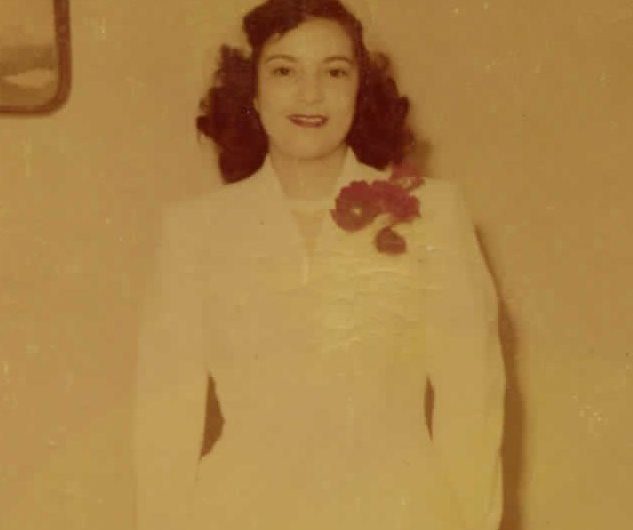
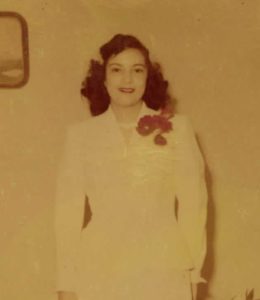
Elsie Weeks in her early twenties
It’s a whole lot of energy, a whole lot of history and a whole lot of living packed together in this two-bedroom duplex located at the Woodlands, the Eastern Shawnee Elders Complex in rural Oklahoma. That’s because the dynamic mother-daughter duo of Elsie Weeks, 86-year mother, and Nancy Weeks, daughter, live together.
Let’s begin with Elsa or Elsie, as most people know her. Born January 3, 1933, this 86-year-old matriarch is the youngest of six children born to Alex and Amy Peacock. Those six were Ernestine Peacock Bradley, Margaret Peacock Dry, William Reid Peacock, Helen Peacock Gray, Harvey Peacock and Elsie Peacock Weeks. A combination of Eastern Shawnee and Wyandotte, Elsie proudly stretches out her hand and gesturing along her torso proclaims, “From the tip of my toe to the top of my head, I am Indian blood.” Some people refer to that as “full blood” while others use the terminology of “four-fourths (4/4)”, meaning that full blood refers to exclusively one tribe while four-fourths means all Indian but more than one tribe. Either way, few people can make that statement, so Elsie has every reason to be proud.
Another unique aspect of Elsie is that she attended the Wyandotte Indian School years 6, 7, 8, and 9 then transferred to Chilocco Indian School for grades 10, 11, and 12 graduating in 1951. She was quick to add that she didn’t like attending Chilocco, primarily because she had to be away from her mother. Particularly close to her mother, Elsie didn’t want to leave to get her education but her mother insisted. Elsie described her mother as “being a tough cookie, a firm believer in education,” so firm that all six of the children graduated from high school, a rarity in those days. Elsie’s favorite memories of childhood included picking wild onions and blackberries with her grandmother, Carrie BlueJacket, and the green grape pies she made. She also fondly remembers her parents speaking in Shawnee to keep the kids from knowing what they were saying but unfortunately Elsie and her siblings didn’t learn the language. Elsie also reflected upon memories of neighbor and newphew John Peacock who had just walked on the week I visited Elsie nd Nancy. Elsie recalled that John and his mother lived in Miami, Oklahoma when Elsie’s mother and father did. In fact John frequently stayed at their house and was best friends with Elsie and Helen Patricia or Patti. Elsie’s love and respect for John was evident as she told how at the age of 8 or 9 John had a paper route and he used that money to take care of his mother when she wasn’t able to work because of a broken tail bone due to her missing a chair when she went to sit down. “He was a mama’s boy, such a little bitty thing, taking care of his mom, even financially with his own money,” she recalled, wiping tears from her eyes as she spoke.
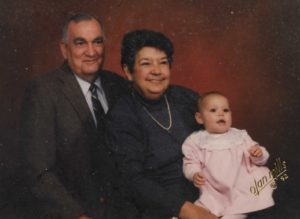
Elsie Weeks, her husband Joe and Granddaughter Amy June
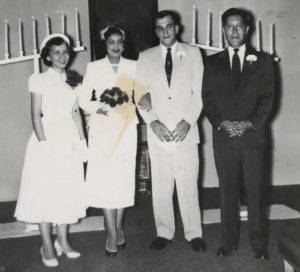
Wedding picture of Elsie and Joe Weeks
Concentrating on Home Economics and Secretarial courses at Chilocco, Elsie and her friend Edna Howerton went to Washington D.C. following graduation, where both worked for the government in an office job. When asked specifically what she did, Elsie jokingly responded, “Oh jack of all trades and master of none.” Later she stated she worked in D & B. Not knowing what that meant, I asked Elsie to explain and she laughingly said, “Death and Birth.”
On August 6, 1953, two years after arriving in DC, Elsie married her husband Keith, who was always known as Joe. It was the beginning of a new career for Elsie, a military wife. Her husband was a career man in the Marine Corps which necessitated their moving frequently, causing daughter Nancy to interject and describe their life as nomads or gypsies, living in various places both in the US and abroad. Ultimately Elsie and her husband became parents to three daughters: Wauleah, Nancy Lee and Debra.
At this point the story line turned to daughter Nancy who also lived a nomadic, gypsy style life due to her career in Commercial Aviation, specifically regulatory compliance. Never married, work became Nancy’s life and an interesting life it was. She was one of the first females to make a career in Commercial Aviation. In 1985 she was parking planes at Dulles Airport in Washington. “Those were really big planes, planes holding four to five hundred passengers. Few women did this and the bias was rampant. I was promoted to lead agent within six months, one of 11 women in a fleet of 700 employees. My work took me to live in Philadelphia, then Cleveland, on to Houston where I did safety manuals. Ultimately I focused on regulatory compliance involving 18 international airports and agencies such as OSHA, EPA, NTSP and others. Then Southwest offered me a job supervising fourteen employees in drug and alcohol testing which I did for fourteen years. Never once in that time did I have a notice of violation. Life was interesting. I was never a domesticated goddess. In fact, I must be the worst cook in the world. I ate mostly in hotels, ate good too. Made good money too. But then Dad and Mom’s health wasn’t very good and they needed help. I retired in 2008, to take care of my parents. So here was this female who has traveled the entire world, fifty plus in age, having her father teach her how to cook. Oh brother! I did get a little help from Mom and today I excel at fried rice, do a mean Yankee Pot Roast, but with Dad’s military background, SOS was his favorite.”
Nancy’s dad passed away in 2014. Lovingly she recalled details of his funeral at Arlington National Cemetery in Arlington, Virginia, the maroon and gold colors of the Marine Corps, the 21-gun volley associated with deaths of Presidents but also signifying the highest of military honor. Looking over at her mother Elsie, Nancy softly added, “When her time comes, she will be cremated, taken back and placed with him.”
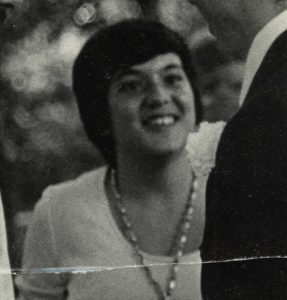
Nancy Weeks, Daughter of Joe and Elsie Weeks
When asked why she and her mother chose to move from Virginia where they had lived so long to the Woodlands near Wyandotte, Oklahoma, Nancy said health care has put them in the poor house. Nancy has rheumatology which requires extensive treatment and medication. She explained that with her previous insurance her co-pay went from $35 to $75, with $5,000 out of pocket per treatment plus, within 4 months she was $20,000 in the hole. Here she is able to access the Indian Health Care at Bearskin Clinic, jointly owned by the Wyandotte and Eastern Shawnee. Her final comment was, “It’s been quite an adjustment. When people are older and in poor health, insurance companies put the premiums up so high that people can’t afford it. Thank goodness for the tribe.”
Nancy went on to praise other aspects of the tribe, saying everyone is so friendly. She praised neighbors Gary, recently deceased John and Joe and Norma Kraus. She was especially complimentary of the nutrition centers’ employees, Susan Patterson and Leia Foster, who deliver meals to Nancy and Elsie. “Not only do they bring good food (you remember what I said about my being a domestic goddess), but they are absolutely wonderful. You couldn’t have better employees. Mom and I both have extreme difficulty getting around and when Susan or Leia deliver the meals, they always ask, “Are you OK? Do you need anything? Do we need to put something away for you? Do we need to feed the dog?’ Then smilingly Nancy adds, “Plus the Outpost Casino is right here and on weekends when we don’t get meals delivered, we are able to drive there and eat. They have great food. Mom loves the ribs and I like the mushrooms. They have good sandwiches too.” About that time the little dog affectionately known as “The Beast” rouses, begins barking and Nancy states, “Plus you can have a dog and everybody knows, ‘Life’s better with a ShihTzu.”
The entire time Elsie or Nancy talked, Nancy was intermittently on the computer. I asked her if she happened to be playing a game. She smiled, nodded her head and said, “Yes, it’s League of Angels. I play with people around the world.” So appropriate for two dynamic ladies who spent much of their lives traveling the world.

GEORGE ANDREW DUNSHANE
“You’ll never live to be 30. You don’t like to talk but you sure love to drink and then you fight. Just look at your hands. They’re all busted up from fighting. You gotta quit this drinkin’, even if it means you gotta change friends cause it’s just their nature, their culture to drink. Ya gotta quit it or I’m a tellin’ you, you ain’t gonna live to be 30.”
Those words of advice were given to George Dushane more than 60 years ago and he’s still going strong. Yes, he has given up the drinking, has given up the fighting, but he still doesn’t like to talk. “He’s quite a character,” laughs his nephew, Cliff Carpenter, “always has been, always will be. You’re lucky that he will talk to you, as he doesn’t talk to too many people.” “I can’t talk to many”, George says in an immediate come back, “because they’re all dead.”

Front row (left to right) Colleen Carpenter, George Dushane, Lola Perkins. Second row: Sherry Barrett, Nancy Spencer, Robin Dushane, Larry Dushane, Martha Dushane. Third row: Jack Dushane, unidentified, David Carpenter, Angela Carpenter. Dushane family members on Ohio trip.
Now 90 years of age, George lives in Joplin, Missouri, where he has lived since the age of 4 and the last 40 years he has lived in the same house. George was born August 1, 1928 in Ottawa County, state of Oklahoma. His father was Clifford Oliver Dushane whom George described as a horseman. Lillian May Choteau, his mother, was Seneca Cayuga. Actually, George indicated he is 11/16 Indian with blood lines in five tribes—Eastern Shawnee, Seneca Cayuga, Cherokee, Wyandotte and Loyal Shawnee. His parents affiliated primarily with two tribes, Eastern Shawnee and Seneca Cayuga. George said they went to more Seneca Cayuga gatherings, especially Green Corn, than they went to Eastern Shawnee events because the Eastern Shawnee didn’t have any. The family included three siblings: two brothers, Franklin Delano, who died at 14 months of age, and Gale Harlan, a Korean veteran, who walked on about 2007. Then there was his favorite sibling, his sister, Colleen Joyce Carpenter, Cliff’s mother, who passed away last year, 2018. George’s grandfather was Andrew Dushane, a former Chief of the Eastern Shawnee.
Education for George included his going to several schools, most of them in Joplin. Even though he was 11/16 Native American, George said his parents never sent him to the Indian School at Wyandotte. George completed the eighth grade and then quit school. He related that when he went to school in Joplin the schools were segregated, with blacks going to a separate school and he went to what he described as a “white school.” Because he was dark complexioned and darker than all the other students in the “white school,” he said kids often made comments about him. “Caused a lot of fights” was theway George described it. “I always took up for myself. I was always known for being self-sufficient. Even today at the age of 90 I would describe myself as a self-sufficient man.”
“That doesn’t mean that I just care about myself. I always took care of my mother. When I grew up I lived here in Joplin, she lived down in Oklahoma. I would go down, pick her up, take her where she wanted to go, did odd jobs for her. Helped her however I could, whatever she wanted, whatever she needed. I even built a lean-to for her. I just didn’t want to stay down there. Didn’t care about being down there. And my sister Colleen was always special to me. She and I were close, even when we were young. We both liked art. Colleen was a good artist. For me it began in the third grade. I had a teacher who liked a drawing I made of some flowers. I think they were iris or what we called flags then. She took that drawing around to the entire school and showed it off. She was proud of that piece, proud of me. That made me feel good.”

George Dushane and unidentified person.

George Dushane and his mother Lillian.
“I still like art today. I’ve kept a few pictures of mine for myself. Had them a long time.” He then looked at his nephew, Cliff Carpenter, who had driven him down to my office from Joplin and said, “Cliff will get them when I’m gone.” Cliff, a professional artist himself, smiled and commented, “He’s too modest. He’s an excellent artist. He paints, draws, did a black and white portrait of Quapaw’s last hereditary Chief, Victor Griffin. He also does scratch board type art. I remember seeing a painting he had done of Indians in a field on horses. The painting was hanging on George’s wall. It inspired me to be an artist, so George is responsible for that. He once had a certain letter from a fairly famous artist telling him how good George’s art work was. You might have heard of him—Charles Banks Wilson”, he said with a smile. “George threw the letter away, said it got old and at his age it was time to start throwing things away.” With a smirk crossing his face, George nodded, said “Just a couple of weeks ago I threw away a letter from my brother when he was in Korea. Had it for 60 years, about time to throw it away.”
Married twice, first to Donna Sue Duncan and second to Delores Cassarina, George has two children, daughter Georgia Sue and son Rick. He used to tinker with cars, especially Volkswagen beetles, or slug bugs as they were frequently referenced. It was not uncommon for him and his nephew David to take off on one day trips to Eureka Springs for car shows. George made his living as an electrician. It was a life long career as he worked for Eagle-Picher 32 years and 7 months, retiring in 1994 at the age of 65.
Today George lives alone, practicing that self-sufficiency of years past. He is thankful for a good neighbor who looks in on him, takes him places, and for Cliff. He used to go out to eat frequently, but now says because of his shaky hands he stays home, does his own cooking. He listens to a lot of TV. Note the word listen. He says he turns it on for the noise, does watch the news but isn’t interested in sports or soap operas.
George says he has no desire to be active in the tribe but is appreciative of the benefits he receives. Those benefits include utilities, insurance on house and car, even though he has almost quit driving. He was most appreciative that when he had to have his eyes operated upon the tribe paid that bill. He repeated that he was most thankful. George summed his life up saying, “I stay busy. My neighbor mows my grass, but other than that Thomas, my cat, and I pretty much stay in the house, spend most of my time alone because I have outlived everyone else. I passed that thirty year mark long ago. Occasionally I shop for groceries at Walmart which is close to where I live and I do my own cooking. At this stage of life, lot of things you do because you have to, not for fun. I’m not complaining. As I said, I’ve always been pretty self-sufficient.”


Recently the Eastern Shawnee Tribe of Oklahoma opened our Law Enforcement Training and Shooting Complex located on Stateline Road aka Cemetery Road just outside city limits of Seneca, MO. The Complex is located on 456 acres in Oklahoma we purchased from the Martin brothers who purchased the land from the Tripoli plant in Seneca. Many people don’t know that Tripoli is a soft type rock or mineral found in very few places in the world, with the area around Seneca, MO being one of those locations. Following are other Tripoli facts shared by Bruce Anderson, current owner of the Tripoli Plant located in Seneca, just a block from our Bluejacket Complex.

“Seneca Standard” Tripoli was first discovered in 1869 in the extreme southwestern corner of Missouri. This was one year after the town of Seneca was formed and two years before the arrival of the railroad.

Tripoli is an industrial mineral primarily used in buffing and polishing compounds designed to polish/shine metal. Tripoli primarily relies on two industries: construction and automotive. Many products used in the home or office building such as, door knobs, faucets, light fixtures, pots and pans, musical instruments, etc. are quite often polished with a compound made containing Tripoli. Other uses include the abrasive in brake pads and a filler/extender in paints and concrete.

Commercially valuable Tripoli is found only on the northern coast of Spain and in the vicinity of Seneca, Missouri. The Tripoli found in the Seneca area extends roughly eight miles into Ottawa County, Oklahoma. Our Tripoli is mined by pushing the overburden out of the way with a dozer. Then, the Tripoli is loaded into dump trucks and hauled to drying sheds where it will stay for 8-12 months. A drying shed is a building with a roof and no walls. This allows the wind and temperature to assist in drying out the Tripoli before it is hauled to the processing plant. When the crude Tripoli is adequately dried, it is hauled to the processing plant where it is crushed, dried, sized, and packaged (50 lb., 100 lb., 2000 lb. bags) so it can be shipped literally all over the world.
This shooting range is located in a 456 acre plot of land that included three Tripoli deposits. Mining was completed on this plot in the late 1980’s. American Tripoli has a very good reputation with the state of Oklahoma and the Federal authorities of restoring land, when the mining is completed, to its original state.
The Eastern Shawnee Tribe purchased this 456-acre tract in 2014 and opened the Training Center and Shooting Complex in 2018.
Bruce Anderson, Tripoli Owner, 2018
Feel free to visit the company’s website
at www.AmericanTripoli.com.